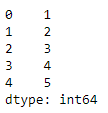在Python中使用Pandas创建并显示一个类似于一维数组的对象
Series()是Pandas库中的一个函数,它可以创建一个一维数组,并且可以在其中容纳任何类型的对象或数据。在这篇文章中,让我们学习一下语法,使用Pandas库创建并显示包含数据数组的一维数组状对象。
pandas.Series()
语法: pandas.Series(parameters)
参数 :
- data :包含存储在系列中的数据。
- index : 数值必须是可散列的,并且与数据具有相同的长度。
- dtype :输出系列的数据类型。
- name : 给予该系列的名称。
- copy : 复制输入数据。
返回:一个系列的对象
例1:从列表中创建系列
# import the library
import pandas as pd
# create the one-dimensional array
data = [1, 2, 3, 4, 5]
# create the Series
ex1 = pd.Series(data)
# displaying the Series
print(ex1)
输出 :

例2:从NumPy数组中创建一个系列。
# import the pandas and numpy library
import pandas as pd
import numpy as np
# create numpy array
data = np.array(['a', 'b', 'c', 'd'])
# create one-dimensional data
s = pd.Series(data)
# display the Series
print(s)
输出 :

例3:从字典中创建一个系列。
# import the pandas library
import pandas as pd
# create dictionary
dict = {'a' : 0.1, 'b' : 0.2, 'c' : 0.3}
# create one-dimensional data
s = pd.Series(dict)
# display the Series
print(s)
输出 :

例4:从列表的列表中创建一个系列。
# importing the module
import pandas as pd
# creating the data
data = [['g', 'e', 'e', 'k', 's'],
['f', 'o', 'r'],
['g', 'e', 'e', 'k', 's']]
# creating a Pandas series of lists
s = pd.Series(data)
# displaying the Series
print(s)
输出 :

 极客教程
极客教程